GAETANO PESCE IS MOULDING OUR MINDS
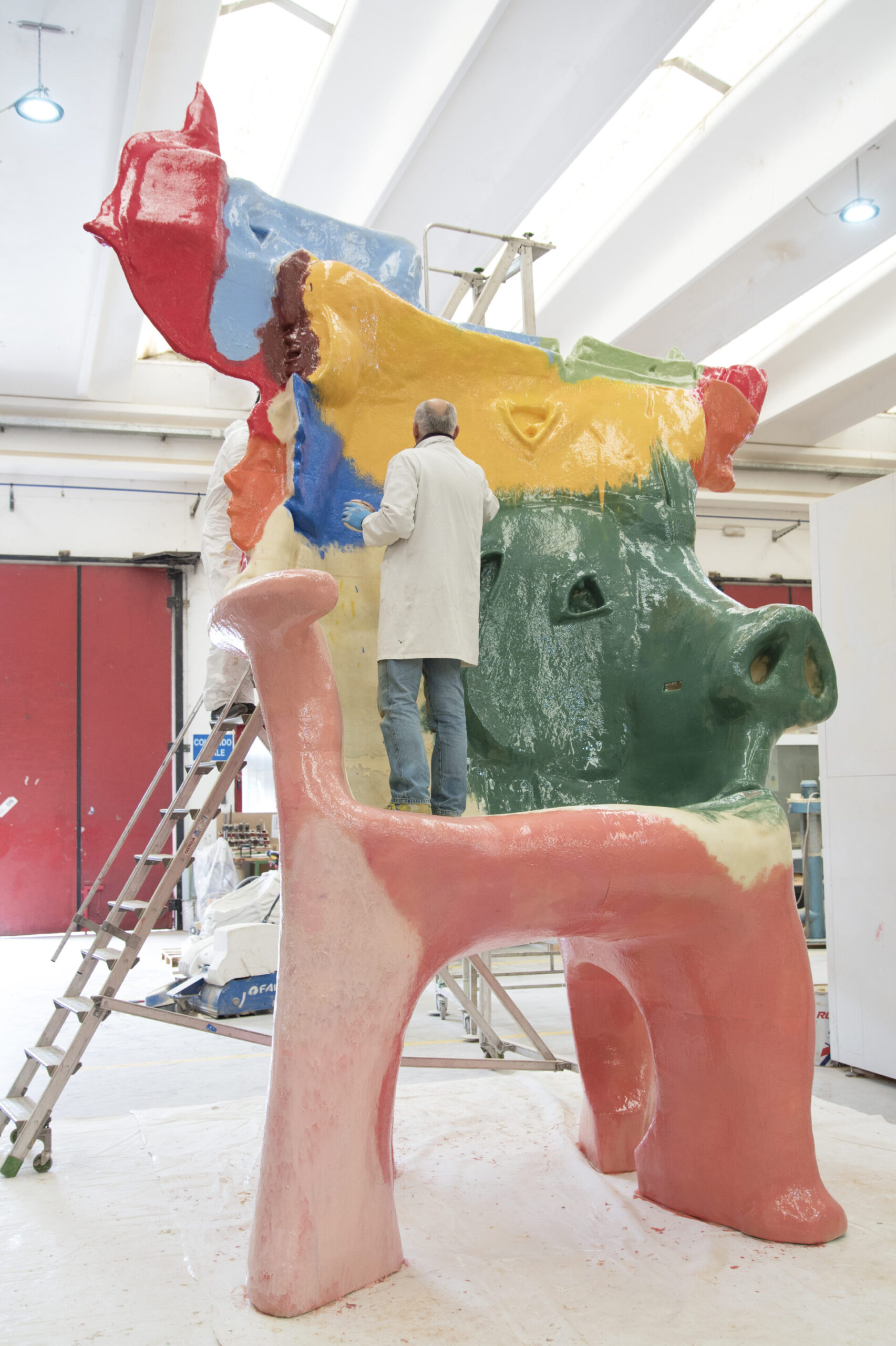
Gaetano Pesce is an autodidact of sorts. Having sustained a successful career in architecture from a young age, Pesce learned early on that buildings and objects are not only functional, but also vessels for creative and philosophical thought. “I was influenced by this idea that an object is not only a chair where you sit; the chair as a form or a concept makes people think. And that is very important,” he triumphantly tells us. Pesce’s works are certainly channels for heightened thought, particularly his armchair works Up5 and Up6, which prompted widespread feminist controversy in the art world. “In reality, women today are prisoners of prejudice,” Gaetano notes. “If you do work that is not creating debate or discussion, it means there is no interest in that work.” The Up series is a tremendous example of Pesce’s political yet philosophical take on the world around him. On a wintry evening in New York City, connected via video to Melbourne, Gaetano, dotCOMME owner Octavius la Rosa and Annabel Blue sat down to discuss the artist’s philosophical take on design and the meaning of life.
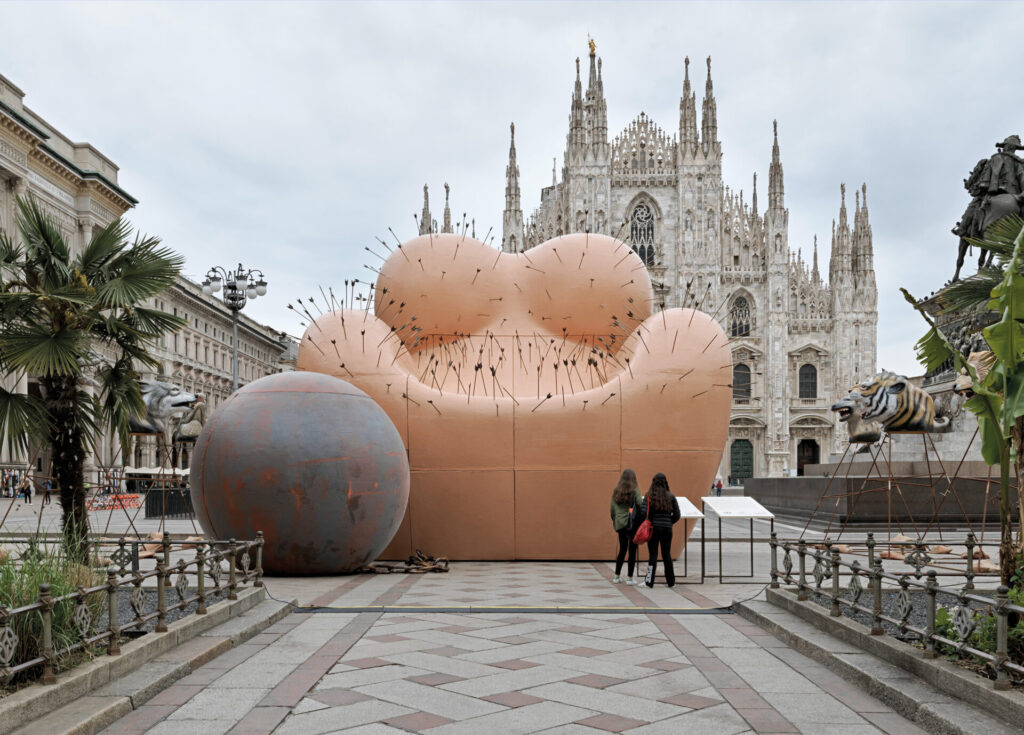
Gaetano: How are you both?
Annabel Blue: We’re good, how are you Gaetano?
GP: I am very well! Octavius, tell me – what do you do?
Octavius la Rosa: I have a business selling vintage Japanese designer clothing, it’s called dotCOMME.
AB: We’re actually sitting on your furniture as you can see! [Everything in view is by Gaetano]
AB: We want to ask you a couple of questions about your work and how you manifest your ideas, but I want to begin with your work in architecture and where it all began for you.
GP: I studied architecture but then when I was young, about twenty-four years old, I met a very smart woman who showed me that something more interesting than architecture was the world of objects. She was studying sculpture, and I was studying architecture. But then we both went to this school in Venice. The new school was industrial design. I would often follow what she was doing and it was at this moment, through her, that I understood that objects were not only practical or comfortable or elegant, but also an explanation of something. And so from that time, since my early twenties, I have been influenced by this idea that an object is not only a chair where you sit – the chair as a form or a concept makes people think. And that is very important.
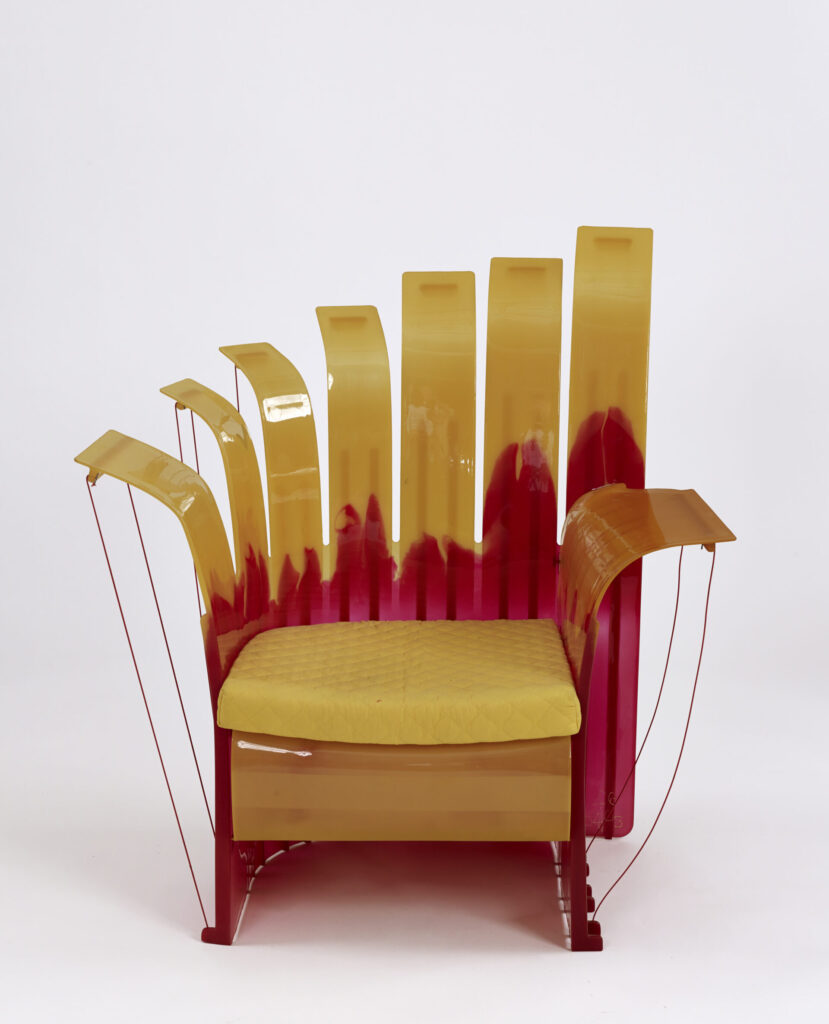
AB: Can you tell us about the Up5 and Up6 chairs?
GP: Yes. When I was 29 I made this really famous chair called the UP5 and UP6. The chair was comfortable and easy to make, but there is a ball attached to it and that ball evokes an image of a prisoner. In reality, women today are prisoners of prejudice. And it’s the prejudice that comes from men. Men wanted or want to control women, and in some countries they are really suffering from this prejudice. In certain countries women cannot go out alone in a public space, they have to be always with someone. There are women who are stoned because they betray their husband, which is totally surreal to stone someone until they die because they are in love with someone else. Even in this civilised country, women when they do the same work as men are paid less. So there is a lot of injustice in the world and that this is represented by that chair. The chair became a piece of art because it made people think. It is better than a traditional sculpture, because instead of sitting in a museum the chair goes to the house of people. Millions of copies were made, and so millions of people have this chair and this message.
So what happened when I met this fantastic woman who is more intelligent than me, she taught me that the object is important. Then slowly I understood that architecture is also very important. We have the same architecture globally – Australia, Japan, Russia, China, Sweden, Latin America, here in New York, we have the same architecture. And this is another mistake because each place has an identity. I think the representation of architecture should be recognised and not a geometrical form that means nothing.
AB: I was listening to an interview and you were talking about materials of various time periods and how you use the materials that you do because they represent a specific time or capture the identity of the current moment. Can you speak more to this idea?
GP: The story of the material is very important to me because when I visited this school, I realised I have studied only traditional materials, in fact, I didn’t really study materials at all. And so I sent three letters to building companies and asked them if I could come, as a student, and see what they were doing. Two companies answered, one in France and one in Germany, and I went to visit. The one in Germany was the most interesting. There I saw incredible new materials, very shocking, and that opened my mind. The materials of our time were better than traditional materials, like stone, metal and glass. I don’t use those because I believe, if I’m being honest, that I have to use materials from my time. If I have to travel, I don’t use a horse – I use the airplane or a train. I use something from my time. If I dress, I dress in a way that is related to my time. All this is the behaviour of a creative person. You have to use the materials from your time, subjects from your time, values from your time.
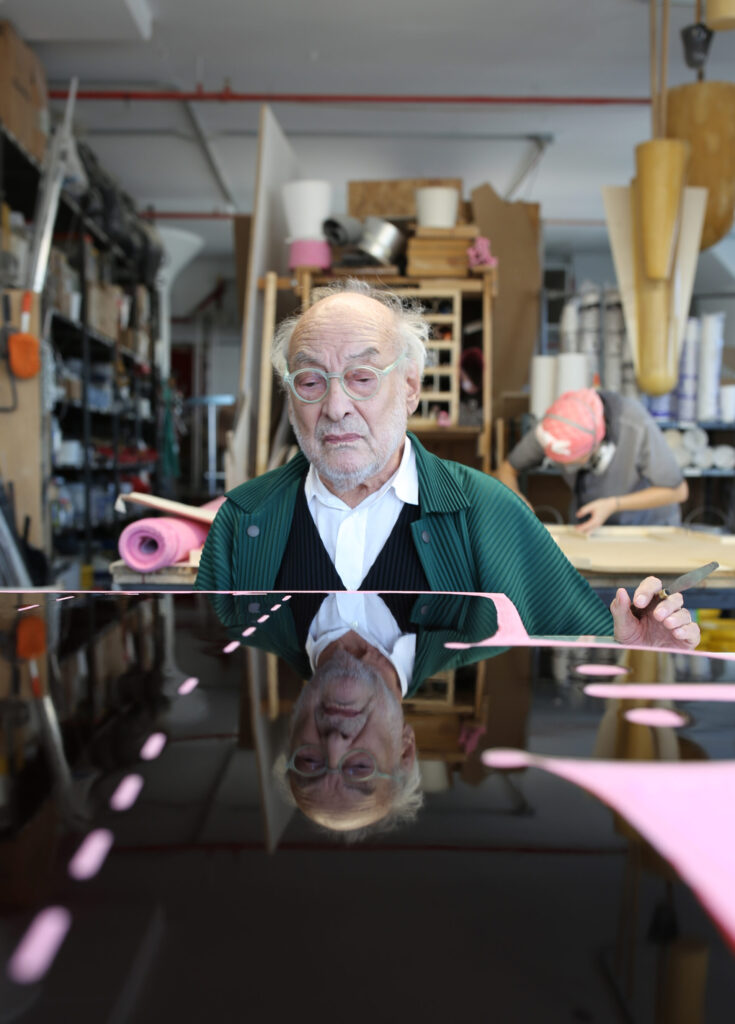
GP: Octavius, I know that you collect my work!
OLR: Yes, I do! I actually have a question for you. Do you think that design needs to be injected with a philosophical or political point of view? Or can design be just for enjoyment?
GP: Look, the future of the object is that they are related to our time and are expressing concepts. And the concept could be political, religious, philosophical or existential. This is the future of the object. And I believe this because architecture can be the same way. Find me a project in Australia and I will do a very simple example of what I am saying.
OLR: We can make that happen! [Laughs]
AB: This may be a silly question, but do you sit in your own furniture, or do you collect furniture by other designers?
GP: Only mine [laughs]. You know why I have my furniture? The company that works with me gives me presents. Like this table [points to his own design] is a present. The sofa is a present. I don’t buy objects. [All laugh]
AB: I wanted to take it back to an earlier stage and ask about your childhood in La Spezia. Did your upbringing influence you creatively at all?GP: I spent only eight months of my life there. My father was in the navy and La Spezia is on the sea. I was born there. And then I moved to other cities until my father died in the war. Then we went to Venice.
AB: And when and why did you move to New York?
GP: I came when I was 24 because I did a show at MoMA. And so, my relationship with New York started a long time ago. Then I did another very important exhibition in 1972, at MoMA again. After this I started to get a market here, selling my drawings and objects to collectors. At that time I was living in Paris, but I decided to move to New York. It was 1980. Why New York? Because it is the capital of the world. If you walk on the street, you see people dressed in a certain way, and after six or seven years you see people from other countries dressing in the same way. From a cultural point of view, it is very interesting. Not because of the museums, but because the atmosphere and culture in the street is very strong. People are very creative here. You feel in the air they have a lot of creativity. And if you are able to understand this, then you are able to understand where our time was born. In New York we have a hundred cultures because we have so many minorities. When you compare that to Shanghai, it seems like a village because this city has a unique culture. New York’s identity, culture and expression are all seen on the street. It is beautiful because when you observe this kind of diversity you are able to understand the quality of our time. Where there is diversity there are ideas.
AB: What has changed culturally since you arrived?
GP: Interesting question. When I was here in the ’80s I thought New York was declining, and was less interesting. I made a sofa called Sunset in New York (1980), meaning New York is going down, like the setting sun. But the reality is that this was a mistake. New York was very strong. Also, even if we have a mayor that is not a genius or we have politicians that are not fantastic, New York still remains very powerful as a place and as a community.
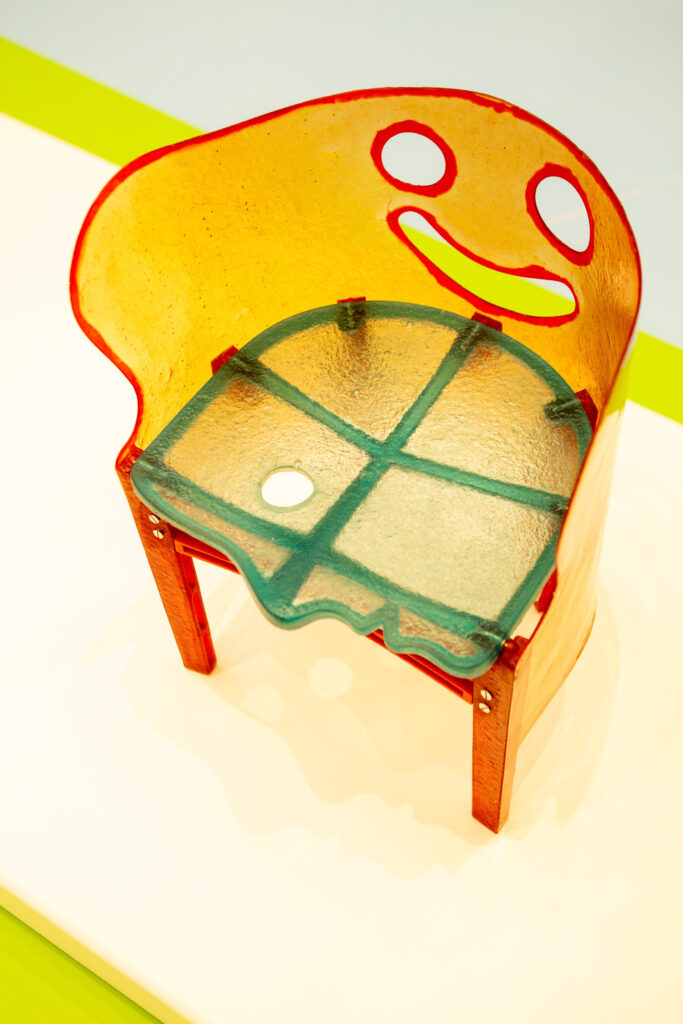
OLR: Have a lot of creative people moved out of New York recently, would you say?
GP: Yeah, but I don’t know who they are. Because I didn’t move from New York, I stayed. So if someone moves it means they are not very attached to this place. And where are they going? New York is real, it’s not artificial. Leaving New York is like cutting your roots, in a certain way. You understand?
AB: Absolutely. You once said that your design raises debate. Do you think art and politics are naturally intertwined?
GP: They say that I am the only one in the world who did this kind of research and production. In reality, my design creates debate. You see, this is very normal. If you do work that is not creating debate or discussion, it means there is no interest in that work. When you provoke people with a new work or project, then it generates interest and you can connect with people. Even if they don’t like it, they will try to understand it. And this is very important because our function as an artist is to bring the future into the present. In doing so, we discover new values that people have to learn to understand. And there may be a moment of friction, but this is our job. A job of making people understand new values. New values can be new ways to think or dress. It is culture.
OLR: What values would you like to impart on people who are interested in your design?
GP: First of all I am very old, so I have already met a lot of people. I like to do things today that are different to what I did yesterday. This is very important. Otherwise, my brain becomes too repetitive. I’m always researching something new that is not familiar, different to what I have done before.
gaetanopesce.com
Artist Josh Robbins On 'Natural Abstraction'
By Riley Orange
Artists in Conversation: Gabriel Cole and Brendan Huntley
By Rachel Weinberg
The Artists are In Charge: Anna Horne and Henry Jock Walker talk Neoteric
By Anna Horne and Henry Jock Walker
OPEN HOUSE: A NEW ERA
By Alexia Petsinis
Diego Ramírez
Vampires of the Earth
By Georgia Puiatti
SAM QUEALY
By Katie Brown